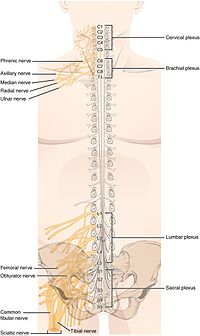
Photo from wikipedia
Background: The purpose of this work was to evaluate the clinical outcomes of triceps motor branch to axillary nerve transfers and to identify prognostic factors which may influence these outcomes.… Click to show full abstract
Background: The purpose of this work was to evaluate the clinical outcomes of triceps motor branch to axillary nerve transfers and to identify prognostic factors which may influence these outcomes. Methods: A retrospective cohort included all patients who underwent a triceps motor branch to axillary nerve transfer (2010-2019) with at least 12 months of follow-up. The primary outcome measure was shoulder abduction strength assessed with British Medical Research Council (MRC) grade. Results: Ten patients were included with a mean follow-up of 19.1 (SD 5.9) months. Compared with preoperative MRC shoulder abduction strength (0.2 SD 0.4), patients significantly improved postoperatively (2.8 SD 1.6; P = .005). Increased body mass index (BMI) was significantly associated with worse postoperative MRC (P = .014). Conclusion: Triceps motor branch to axillary nerve transfer is a beneficial procedure for restoring shoulder function in patients presenting with either isolated axillary nerve or brachial plexus pathology. Patients with elevated BMI may not have as robust strength recovery and should be counseled carefully regarding prognosis.
Journal Title: HAND
Year Published: 2022
Link to full text (if available)
Share on Social Media: Sign Up to like & get
recommendations!